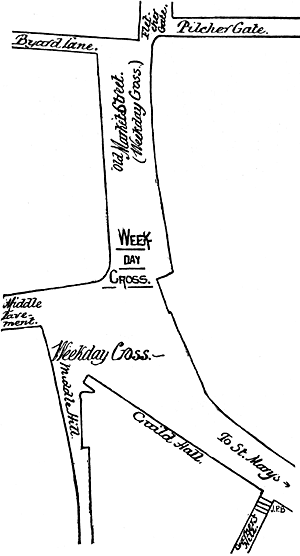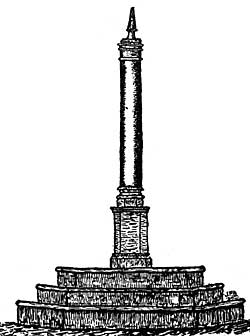The Weekday Cross at Nottingham and its associations
By J Potter Briscoe

AT the outset it must be stated to avoid misunderstanding as to the scope of this paper that it is not restricted to the structures known as Weekday Cross, but that it extends to the immediate locality of the crosses.
This piece of land is situated about midway between the ancient parish churches dedicated to St. Mary the Virgin and St. Peter respectively. It stands at an altitude of about sixty-three feet above the summer level of the Trent; and about one hundred and twenty-nine feet above mean level of the sea at Liverpool. This elevated land sloping to the Marsh levels, south, east, and west, has been designated St. Mary's Mount, and St. Mary's Hill.
The district now under consideration is officially known as "Weekday Cross," and comprises areas which formerly bore names which have been, wholly or in part, merged into "Weekday Cross." The southern portion extends, west to east from Middle Pavement and Middle Hill to Garner's Hill and the commencement of High Pavement. From about the centre of this base, Weekday Cross extends northwards to the junction of three streets, now known as Pilcher Gate to the east, Fletcher Gate to the north, and Byard Lane to the west. The distances are 190 feet, and from south to north about 230 feet. The area of the open ground space is about 1348 square yards, or nearly a quarter of an acre. This is one of the most interesting areas in Nottingham, from an historical and antiquarian point of view, only surpassed probably, by the land of an equal area about the southwest corner of the Exchange in the Great Market Place.
Writing of Weekday Cross in his work entitled "Old Nottingham: its streets, people, &c." (1902) Mr. James Granger, says:—"I have often stood in that open space and wondered how in olden times they managed to carry on all the business and attend to numerous other matters upon that circumscribed spot with which they are accredited. For at least several centuries there can be no doubt that this was the busiest part of the town, and in that respect it must be ranked even before the Market Place, which to many persons in recent days will appear singular and almost impossible. Yet there can be no doubt that for hundreds of years in the past the Great Market Place, as regards business purposes was used on Saturday only, and, therefore, we find it referred to in the 'Records' as the Forum Sabbati, or Saturday Market, and to Weekday Cross as the Forum Cotidianum, translated literally the Daily Market."
The objects of interest to be dealt with in this paper will be the crosses, the Guild Hall with its Gaol, its Market and its Bull Ring, Well, and buildings, including a mediaeval chapel; its Charity School, its Town Ditch ; a Poet's birthplace, and other items which should be recorded.
THE WEEKDAY CROSS.
There were two or three erections known to us as the Weekday Cross, but they did not bear that name at the earliest period of their existence. It cannot be stated with definiteness when the earliest crosses on the site were constructed, but it may be surmised with some reason, that one of these was erected about 1529-1530. At that period the Chamberlain's Accounts contained these items of expenditure:—
"Item payde for ij lod (es) ston that was okepyde (used) at the Markyt Crosse.....xxd."
"Item payde to John Mychyll for wyrkng the sam' ston . . . xd."
Item payde for lyme and sande .... ijd."
Item for a pottyll Malse (Malvoisey) that was dro (n) ke at the Crosse on Cobcryste (Corpus Christi) day.....Viiid."
Here then are entries of the purchase of stone, lime, and sand, and of the employment of labour for the working of the stone and probably the erection of the cross. At this stage the cross had probably not acquired a name. It has been conjectured that the last entry has reference to a celebration when the cross was completed.
The earliest of these erections of which we have definite information, was delineated in an unfinished drawing of the locality in which it was situated, by Thomas Sandby,1 at the age of twenty-one. This was reproduced by photography in some copies of Hine's work2 on Nottingham Castle and Town.
In the folding frontispiece to the work cited is a fanciful drawing of the cross, the head of which bears no resemblance to that depicted by Sandby.

Deering, who wrote about the time of the erection of this cross, supplies some further particulars, and indicates its surroundings in these words:—"TheWeekday Cross is ... a column standing on an octangular has is ... with four steps, placed almost in the midst of an open space between the High and Middle Pavement; here the Wednesday and Friday market is kept," &c. This same historian states that "The Mayors and Sheriffs were proclaimed at the Weekday Cross by the Town Clerk."
On page 153 of the "Stretton MSS." is a sketch of the cap of a former cross and a section of the column buried in the foundation of a cross, of which a measured sketch is produced, with a memorandum that the cross was erected in 1745.
Stretton states that the last cross "consists of a single Doric column fifteen inches in diameter, with its pedestal 16 feet 6 (inches) high, elevated on 3 stone steps." More detailed measurements are given in the sketch. This cross was demolished three or four years after the discontinuance of the market on this area; and on November 12th, 1804, the materials were sold by auction to Mr. Benjamin Stoney, a local joiner. These pieces of masonry and the remains of two others found in excavating were, in 1806, "lying together in Sneinton Field where the new village (is) building."
About the opening of the eighteenth century, this cross was probably known as the "Butchers' Cross." In support of this view it may be stated that in a minute of the Common Council of September 20th, 1703, reference is made to a lease of a house "near the Butchers' Crosse." This view is supported by Mr. E. L. Guilford, M.A., the editor of the sixth volume of the "Records of the Borough of Nottingham," who writes:—"At first sight this would appear to be the Butter Cross, situated at the east end of the Market Place, near the Shambles, but it has been suggested that the Weekday Cross may be intended to be referred to, and from the fact that there were also Shambles in the Weekday Market, the suggestion is worthy of consideration."
About 1711 the "Cross" was familiarly known as "The Pillar."
In 1736, the Nottingham Crosses were cleaned at a cost of one shilling and fourpence.
Proclamations were made at the Cross—national and local. In days gone by, Mayor-making Day3 was on September 29th. After the ceremony and the curious custom of burying the mace, the company proceeded from St. Mary's Church to the Weekday Cross, from whence the Town Clerk proclaimed the Mayor and the two Sheriffs of the town.
(1) Thomas Sandby lived between 1721-1798. At the age of twenty-one he produced the sketch referred to, and two years later accompanied the Duke of Cumberland to Flanders as private secretary and draughtsman. From 1746 to 1798 he was Deputy Ranger of Windsor Great Park. In 1768 he assisted in the founding of the Royal Academy, and was appointed its first Professor of Architecture in 1770. Sandby built the Freemasons' Hall, and was joint architect with James Adam to the King. Thomas Sandby was the elder brother of Paul Sandby. the water-colour painter and engraver, who introduced the "aquatint" method of illustration into England.
(2) "Nottingham: its Castle, a military fortress, a Royal Palace, a Ducal Mansion, a blackened ruin, a Museum and Gallery of Art. With notes relating to the Borough of Nottingham," by Thomas Chambers Hine, F.S.A., 1876.
(3) Deering (1751) described the proceedings in this language:— "Divine Service ended, the whole Body goes into the Vestry, where (the old Mayor seats himself in an elbow-chair, at a table covered with black cloth, the Mace being laid in the middle of it, covered with Rosemary and sprigs of Bay (which they term 'Burying the Mace'). Then the Mayor presents the person before nominated to the Body, and after it has gone through the Votes of all the 'Cloathing,' the late Mayor takes up the Mace, kisses it, and delivers it into the hand of the now Mayor with a compliment; who proposes two persons for Sheriffs, and two for the office of Chamberlains. These having gone through the Votes, the Mayor and the rest go into the Chancel, where the senior Coroner administered the oath to the new Mayor, in the presence of the old one. Next the Town Clerk gives to the Sheriffs and Chamberlains the oath of their office. The ceremony being thus ended they march in order to the New Hall, attended by such gentlemen and tradesmen as have been invited by the new Mayor and Sheriffs. In their way at the Week-day-Cross, over against the ancient Guild Hall, the Town Clerk proclaims the Mayor and the Sheriffs, and the next ensuing market-day they are again proclaimed in the face of the whole market, at the Malt Cross."
